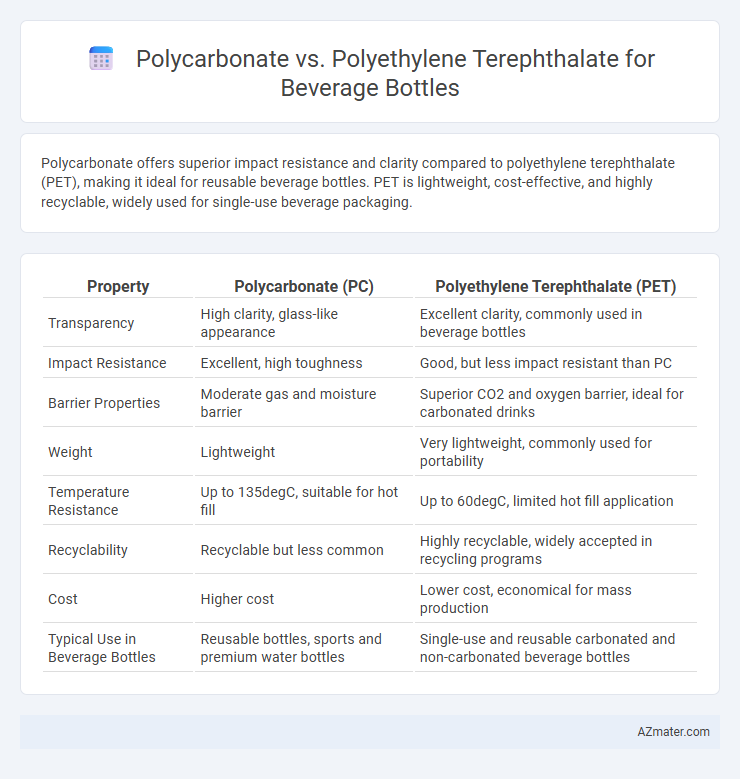Polycarbonate offers superior impact resistance and clarity compared to polyethylene terephthalate (PET), making it ideal for reusable beverage bottles. PET is lightweight, cost-effective, and highly recyclable, widely used for single-use beverage packaging.
Table of Comparison
| Property | Polycarbonate (PC) | Polyethylene Terephthalate (PET) |
|---|---|---|
| Transparency | High clarity, glass-like appearance | Excellent clarity, commonly used in beverage bottles |
| Impact Resistance | Excellent, high toughness | Good, but less impact resistant than PC |
| Barrier Properties | Moderate gas and moisture barrier | Superior CO2 and oxygen barrier, ideal for carbonated drinks |
| Weight | Lightweight | Very lightweight, commonly used for portability |
| Temperature Resistance | Up to 135degC, suitable for hot fill | Up to 60degC, limited hot fill application |
| Recyclability | Recyclable but less common | Highly recyclable, widely accepted in recycling programs |
| Cost | Higher cost | Lower cost, economical for mass production |
| Typical Use in Beverage Bottles | Reusable bottles, sports and premium water bottles | Single-use and reusable carbonated and non-carbonated beverage bottles |
Introduction to Beverage Bottle Materials
Polycarbonate (PC) and Polyethylene terephthalate (PET) are prominent materials used for beverage bottles, each offering distinct properties tailored to packaging needs. PC provides high impact resistance and clarity, making it suitable for reusable bottles and premium packaging, while PET is favored for its lightweight nature, chemical resistance, and recyclability, ideal for single-use bottles. Understanding the material characteristics of PC and PET helps optimize durability, safety, and environmental impact in beverage container applications.
Overview of Polycarbonate (PC)
Polycarbonate (PC) is a durable, transparent thermoplastic commonly used in beverage bottles due to its high impact resistance and excellent clarity. It offers superior strength and heat resistance compared to polyethylene terephthalate (PET), making it ideal for reusable bottles that require sterilization. PC's chemical stability and ability to withstand repeated use without degrading enhance its suitability for long-term beverage storage.
Overview of Polyethylene Terephthalate (PET)
Polyethylene Terephthalate (PET) is a highly versatile thermoplastic polymer extensively used in beverage bottles due to its excellent strength-to-weight ratio and superior clarity. PET offers strong resistance to impact, moisture, and gases, making it ideal for preserving carbonation and flavor in carbonated drinks. It is also highly recyclable, with an established global recycling infrastructure, contributing to its widespread adoption in sustainable packaging solutions.
Chemical Structure and Properties Comparison
Polycarbonate features a carbonate group in its backbone, offering superior impact resistance and higher thermal stability compared to polyethylene terephthalate (PET), which contains ester linkages in its structure. Polycarbonate exhibits excellent transparency and is more resistant to heat and cracking, making it suitable for reusable beverage bottles, whereas PET's semi-crystalline nature provides good barrier properties against gases and moisture, ideal for single-use, lightweight containers. The chemical structure difference results in polycarbonate having higher toughness and temperature resistance, while PET excels in chemical resistance and recyclability for beverage packaging applications.
Durability and Impact Resistance
Polycarbonate offers superior durability and higher impact resistance compared to Polyethylene terephthalate (PET), making it less prone to cracking or breaking under stress in beverage bottle applications. PET, while more lightweight and cost-effective, exhibits lower impact resistance and is more susceptible to deformation or damage from drops or rough handling. The inherent toughness of polycarbonate enhances the safety and longevity of beverage containers in demanding environments.
Safety and Health Considerations
Polycarbonate (PC) bottles may release bisphenol A (BPA), a chemical linked to hormonal disruptions, especially when exposed to heat or wear, raising safety concerns for beverage containers. Polyethylene terephthalate (PET) is BPA-free and generally regarded as safer for food and drink storage, maintaining stability and minimizing chemical leaching under typical use conditions. Regulatory agencies like the FDA approve PET for single-use food and beverage packaging due to its inert properties and lower health risk profile compared to polycarbonate.
Environmental Impact and Recyclability
Polycarbonate (PC) bottles have higher carbon footprints due to energy-intensive production and pose recycling challenges because they can contaminate PET recycling streams. Polyethylene terephthalate (PET) bottles are widely recycled with established systems, significantly reducing environmental impact through closed-loop recycling and lower greenhouse gas emissions. PET's lightweight nature further enhances its environmental profile by lowering transportation emissions compared to heavier polycarbonate containers.
Cost and Manufacturing Differences
Polycarbonate bottles generally have higher material and production costs compared to polyethylene terephthalate (PET) due to more complex polymerization and molding processes. PET is favored for beverage bottles because it offers lower raw material expenses and faster, more energy-efficient manufacturing methods such as injection stretch blow molding. Cost-effectiveness combined with PET's high clarity and chemical resistance makes it the dominant choice in large-scale beverage packaging.
Suitability for Different Beverage Types
Polycarbonate bottles offer excellent clarity and high impact resistance, making them suitable for carbonated soft drinks and water, where durability and visibility are crucial. Polyethylene terephthalate (PET) excels in lightweight packaging and provides superior barrier properties against moisture and oxygen, ideal for juices, teas, and other beverages requiring extended shelf-life. Both materials are food-grade safe but PET's recyclability and cost-effectiveness make it the preferred choice for mass-market beverage applications.
Conclusion: Choosing the Right Material for Beverage Bottles
Polycarbonate offers high impact resistance and clarity, making it suitable for durable, reusable beverage bottles, while polyethylene terephthalate (PET) excels in lightweight properties, recyclability, and cost-efficiency for single-use bottles. PET's superior barrier to gases preserves carbonation and freshness, whereas polycarbonate's thermal stability supports hot-fill applications. Selecting the right material depends on the specific requirements of bottle reusability, environmental impact, and product type within the beverage industry.

Infographic: Polycarbonate vs Polyethylene terephthalate for Beverage bottle
 azmater.com
azmater.com